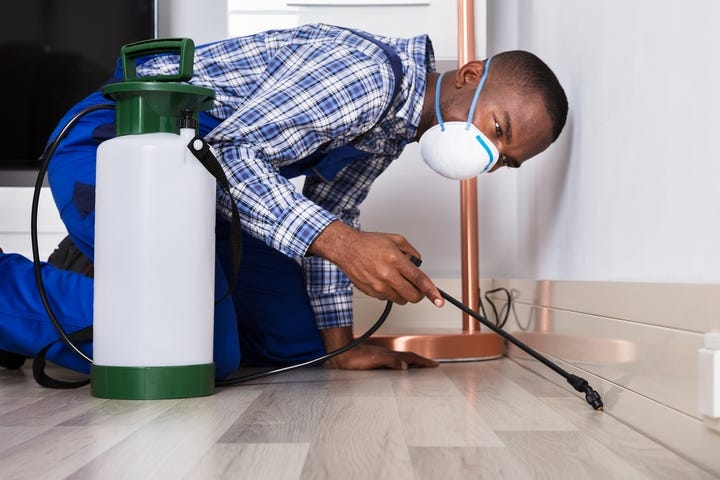Bed Bug Dog Discovery: Detect Infestations Early for Satisfaction!
Bed Bug Dog Discovery: Detect Infestations Early for Satisfaction!
Blog Article
Specialist Parasite Control Techniques for Long-Term Outcomes
In the realm of insect control, attaining continual efficiency and lasting results calls for a careful technique that goes beyond plain elimination. Specialist pest control techniques encapsulate a comprehensive technique that starts with a thorough evaluation and evaluation, complied with by accurate bug recognition to understand their actions patterns. The execution of Integrated Insect Administration (IPM) concepts, combined with eco-conscious treatments, forms the keystone of sustainable bug obliteration. Nevertheless, real examination hinges on the ongoing tracking and upkeep of the dealt with areas, ensuring a pest-free environment for the foreseeable future. By diving right into the details of these techniques, a deeper understanding of professional insect control techniques for sustaining results arises.
Inspection and Assessment
Upon entering a residential or commercial property for bug control solutions, the initial step is a detailed assessment and analysis to determine the extent of the invasion and identify one of the most efficient treatment plan. Expert pest control service technicians are trained to thoroughly check out the facilities, searching for indicators of bug activity such as droppings, gnaw marks, nests, or any structural damage. They will certainly additionally analyze the problems that might be attracting parasites, such as food resources, water leaks, or access factors.

Bug Identification and Habits

Moreover, recognizing the behavior of the recognized pest is essential to applying reliable control steps. As an example, understanding where pests nest, what they feed on, and their activity patterns can help pest control specialists develop approaches to remove them successfully. Some parasites might be nocturnal, while others are more active throughout the day. This understanding permits the application of treatments at optimal times for optimum efficiency.
Integrated Pest Monitoring (IPM)
Integrated Pest Management (IPM) techniques incorporate several methods to manage and stop pest problems in a lasting and eco-friendly way. Exterminator DC. By integrating techniques such as organic control, habitat adjustment, adjustment of social methods, and the use of resistant ranges, IPM aims to reduce making use of chemical pesticides
One of the essential principles of IPM is the focus on prevention. This aggressive approach includes tracking bug populations on a regular basis to find any kind of possible issues before they escalate. By identifying parasite issues beforehand, pest control procedures can be applied quickly and efficiently.
Furthermore, IPM advertises using safe pest control approaches Pest control Washington DC whenever feasible. This can include utilizing natural predators of the parasites, presenting valuable bugs, or utilizing scents to interrupt breeding patterns. By lowering reliance on chemical pesticides, IPM not only safeguards the atmosphere but likewise helps keep a balance in the community.
Environmentally-Friendly Therapies
Applying eco-conscious strategies in insect control treatments can successfully resolve invasions while prioritizing ecological sustainability. Environmentally-friendly treatments concentrate on decreasing the effect of parasite control methods on environments, non-target microorganisms, and human health and wellness. These techniques commonly include the usage of all-natural predators, such as ladybugs or nematodes, to manage pest populations, lowering the requirement for chemical interventions. Furthermore, methods like habitat adjustment, such as changing wetness degrees or getting rid of food resources, can assist deter pests without making use of dangerous compounds.
Another trick element of environmentally-friendly treatments is using natural and eco-friendly products that damage down swiftly without leaving damaging residues in the setting. Botanical insecticides acquired from plants like chrysanthemums or neem use efficient parasite control while positioning very little risk to non-target varieties. Furthermore, employing techniques like heat treatments or pheromone traps can target certain parasites with precision, reducing the total ecological effect of bug control practices.
Recurring Surveillance and Upkeep
Regular security and upkeep are vital elements of efficient parasite control monitoring. Continuous surveillance plays a crucial duty in guaranteeing that parasite infestations are identified early and dealt with immediately. Routine assessments by qualified experts are necessary to recognize any kind of signs of bug activity, examine the effectiveness of previous treatments, and make changes to the bug control plan as needed. By checking bug populaces gradually, pest control specialists can track trends, expect potential problems, and carry out preventative steps to minimize the risk of future invasions.
In enhancement to surveillance, maintenance practices are important for lasting parasite control success. This includes implementing appropriate sanitation procedures to get rid of possible food and water sources for insects, securing off entry points to stop insects from getting in the facilities, and addressing any type of structural issues that could facilitate parasite invasions (Exterminator DC). By integrating recurring tracking and maintenance right into an integrated insect management method, organizations can make certain a pest-free setting and guard their property against expensive damage and wellness threats
Final Thought
In verdict, utilizing professional insect control strategies such as detailed examination and evaluation, exact bug recognition and understanding of their habits, integrated pest monitoring methods, environmentally-friendly therapies, and recurring tracking and maintenance are vital for achieving long-lasting results in insect control. By executing these techniques, people can properly manage insect invasions and preserve a pest-free atmosphere in a lasting fashion.
Report this page